Inside Changi Airport’s emergency service — the team given life-and-death tasks
A dedicated team of firefighters, known as the Airport Emergency Service, are the airport’s first responders. Out of 300 who apply, only about 20 will be selected. CNA Insider finds out what it takes, and what they face.
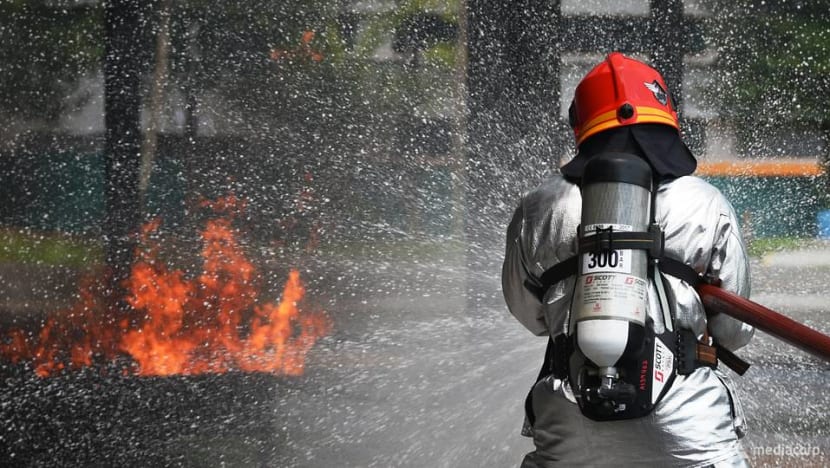
An AES firefighter tackling a pocket fire during a drill. One wrong move and the fire could escalate. (Photo: Marcus Mark Ramos)
SINGAPORE: It was 6am. The team at Fire Station 1 was winding down before their first meal of the day, marking the end of their 10-hour shift. That was when the call came.
Flight SQ368 bound for Milan on June 27, 2016 had an “engine oil issue” mid-flight and was returning to Changi Airport.
“What was going through my mind was definitely all the possible worst-case scenarios,” said Airport Emergency Service (AES) Senior Staff Officer Ang Kheng Wee, the then Acting Operations Commander.
An engine oil issue could result in a loss of control over the plane’s flight capability, affect the plane’s landing operation or cause a fuel leakage on the runway.
The plane was due to arrive in an hour. Waiting for it, and poised for action, was a fleet of firefighting vehicles known as foam tenders, equipped with a mixture of foam and water.
“It was a pretty peaceful initial landing,” said Ang. “No fire, nothing.”
But something caught his eye: A sudden orange glow emitted from the right engine, then disappeared. As the plane approached the taxiway, the engine burst into flames, which engulfed the right wing.
It was “go time” for the firefighters.
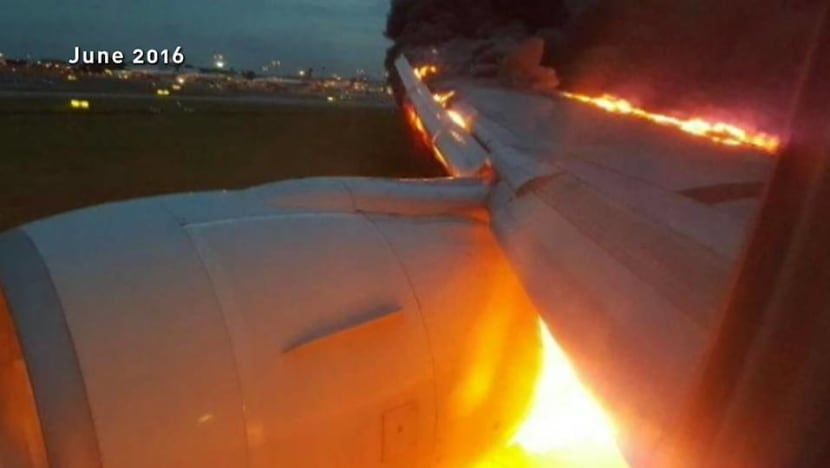
Sirens blaring, the foam tenders sped out in force. The vehicles’ turrets whirred mechanically as they discharged their foamy solution.
“If truth be told, it wasn’t expected that an engine oil issue could lead to such a big fire,” Ang said. “But we prepare ourselves mentally for the worst-case scenario.”
The fire was put under control in about a minute. If there had been any cause for delay, added the 35-year-old, “the passengers could’ve burned to death.”
THREE MINUTES TO SAVE LIVES
For the AES firefighters, seconds mean the difference between life and death.
“Aviation-fuel fires generate more intense heat than normal fires,” said Ang. “The threat of this fire is that it can burn through the aircraft fuselage, through the fuel tanks and subsequently into where the passengers are sitting.”
WATCH: Full emergency - The Changi Airport firefighters (5:00)
In such instances, time becomes even more of a crucial factor. Fires that reach inside the cabin can potentially burn up its roof in 90 seconds, devastating all in its path.
“A car typically carries 40, 50 litres of petrol. And a Boeing 747, for example, can carry more than 200,000 litres of jet fuel,” said Operations Commander Alexander Barry Boey.
“We’ve seen how cars can catch fire, so you can imagine if it were to happen on an aircraft.”
According to a mandate from the International Civil Aviation Organisation, airport fire services must respond to an aircraft emergency in three minutes. But the AES has set for itself a two-minute response time.
“We’re the best airport in the world,” said Boey. “It’s our commitment to passenger safety to hold ourselves accountable to a higher standard.”

The moment any aircraft-related emergency is declared, the firefighters have 15 seconds to get into their firefighting vehicles and two minutes to reach the accident site. Then it is one minute to get the fire 90 per cent under control.
“It’s muscle memory,” said Senior Fire Warrant Officer Shah Rashid. “As long as the bell (alarm) goes, we go.”
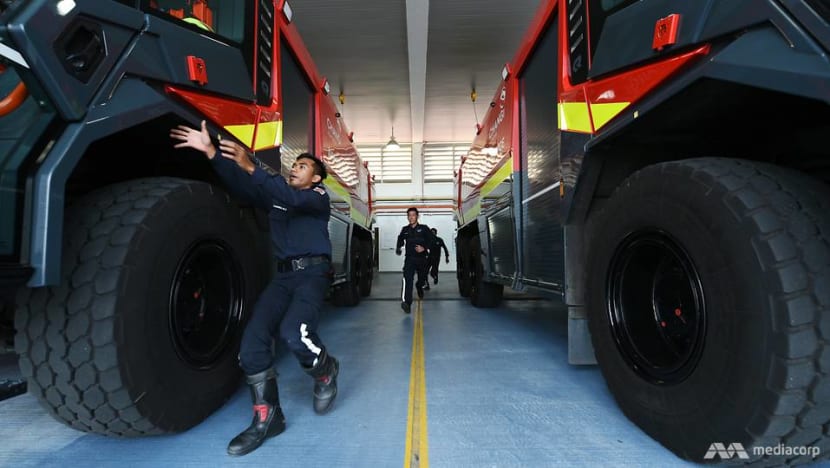
A slow response to an emergency results in uncertainty for others at an airport like Changi, which can have planes taking off and landing on its two runways every 80 seconds.
It could even mean the closure of a runway for several hours — a major disruption. So to mitigate the risk of airport operations coming to a halt, each runway has a dedicated fire station with identical resources.

This gives firefighters a strategic advantage when responding to emergencies, and also means one runway can remain operational should the other be temporarily out of action.
With a full force of 45 men stationed across two runway fire stations, a satellite station and a sea rescue base, the AES team is a lean one. Each firefighter has to be at the top of his game.
‘WE NEED TO STRESS OUR FIREFIGHTERS’
Every year, about 300 hopefuls apply to the AES. The minimum qualification is a National Institute of Technical Education Certificate (Nitec), but the selection criteria focus more on traits like discipline and teamwork.
After two months, several rounds of interviews and physical and medical examinations, the number of successful applicants is reduced to 20.
When Fire Lance Corporal Shek Allaudin was applying, for example, he struck up a conversation with another candidate who he discovered was applying for the eighth time.
“People told me, ‘Wah, AES is more chiong (hectic), more teruk (demanding) than general firefighting,” said the 25-year-old. “I told people, ‘Just pray for me to get in.’”

Getting in, however, is when the hard work begins.
“(We) drill them hard and also inject surprises to make them thinking firefighters,” said Commandant at the School of Airport Emergency Service Leow Eng Hock, referring to the 12 weeks of basic training all new recruits undergo.
(Aircraft firefighting) is an ever-changing environment ... Things can just explode within seconds, aircraft can be ripped into a few parts, and there’s a large quantity of fuel that’s burning.
“We need to stress our firefighters,” added the 60-year-old.
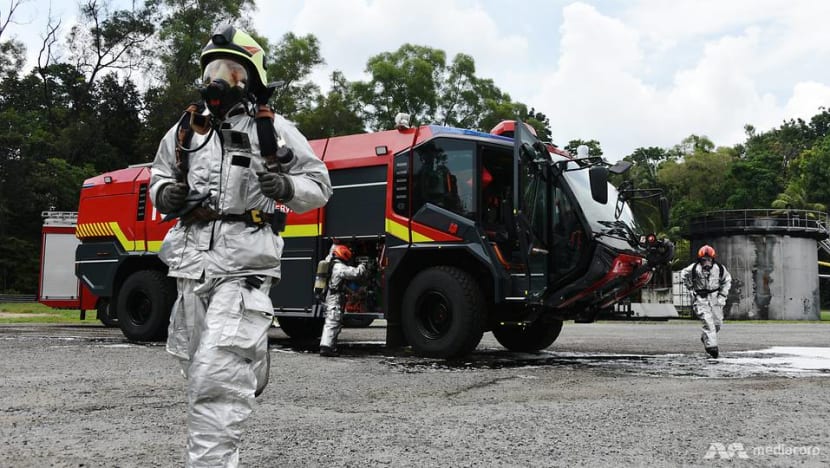
The heat is the most debilitating. After a month of technical training, the recruits are taught to use firefighting suits — 27kg silver aluminised suits that, complete with breathing apparatus, leave no room for ventilation.
To endure working in such heat in full gear for up to 30 minutes takes training and accustomisation.
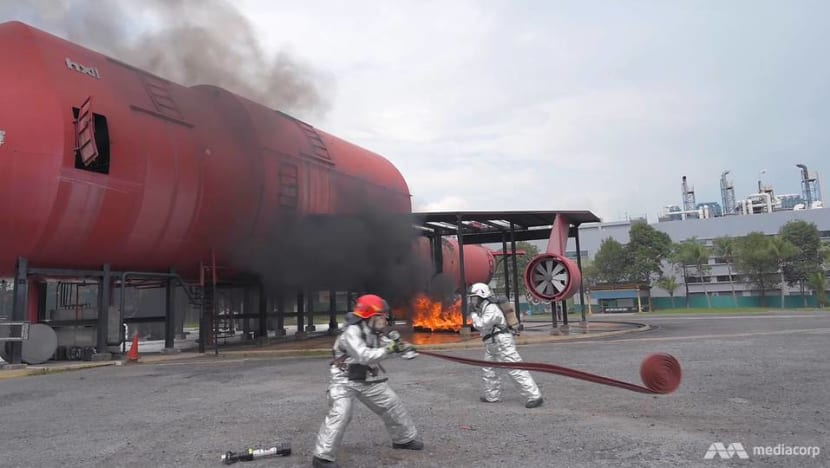
The second month of training is also when recruits get their first taste of aircraft firefighting.
“It was the most challenging task,” said Shek as he recounted the first time he did a night drill. His team of 10 was tasked with rescuing dummy casualties from inside a simulator, referred to as the Red Bird by the firefighters.
There were also internal and external fires, which had to be extinguished. “I took the internal fire,” said Shek, “I wanted the thrill of fighting fire in darkness. I actually look forward to this kind of thing.
“I like to push my body’s limit to the (fullest) extent.”
But not everyone shares the same gung-ho attitude. The dropout rate in the second month is 10 to 20 per cent.
“They (recruits) think that it’s a ... straightforward job,” said Leow. “In fact it’s not, because physically and mentally, they need to prepare themselves.”
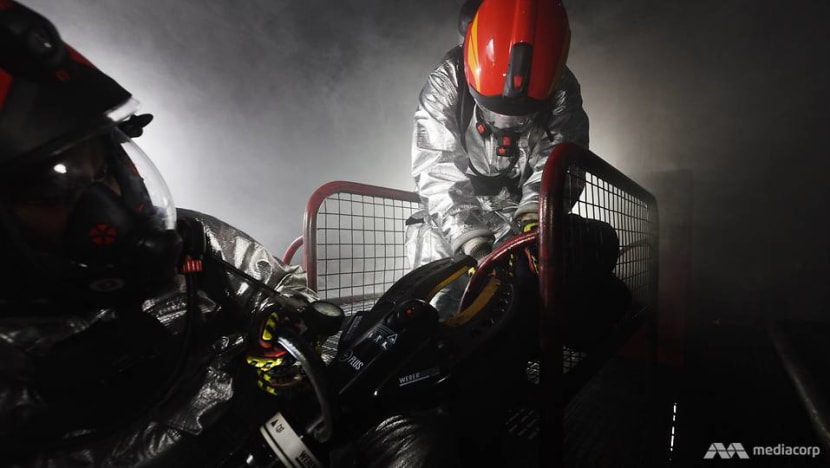
ENTER THE CAGE ROOM
For additional realism and the element of surprise, trainers can turn up heaters in a room known as the cage room, fill it with smoke and turn on sound effects of screams, crying and sirens.
This is where firefighters work together in a simulated mission. Crawling through cages and tunnels, they must search for and retrieve “casualties”, usually scattered around randomly, and find their way out of the snaking maze — all in total darkness.
“It’s to overcome their fear of darkness” said Leow, explaining that firefighters cannot panic if they find themselves in an enclosed environment.
Under the weight of their suit and the heat, they must maintain a steady breath so that their oxygen tank is not depleted before they can make their way out of the cage with their casualty.
“The most important is the teamwork ... communication among the team and making sure there’s no man left behind,” Leow said.
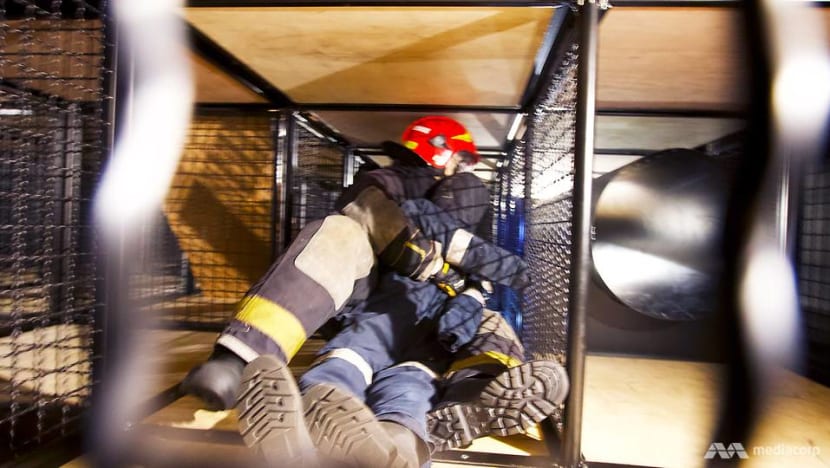
Through thermal imaging cameras, trainers assess whether the firefighters make the cut. “We see whether mentally they’re resilient enough to react to all kinds of changing scenarios," said Leow.
The same logic applies in the foam tender simulators. Firefighters training to operate the vehicles enter a room with an LCD screen, a chair and a dashboard identical to that in operational foam tenders.
The screen lights up, and faced with a digital replica of Changi Airport’s runway, the trainee waits in the hot seat for instructions. “Runway one … engine one and two on fire,” relays the officer from the tower. “Be advised.”
Then a plane emitting smoke cuts across the screen, and the firefighter moves off in pursuit. As he makes a sharp left turn at 120 kilometres per hour, the trainers throw him a curve ball: It starts pouring with rain.
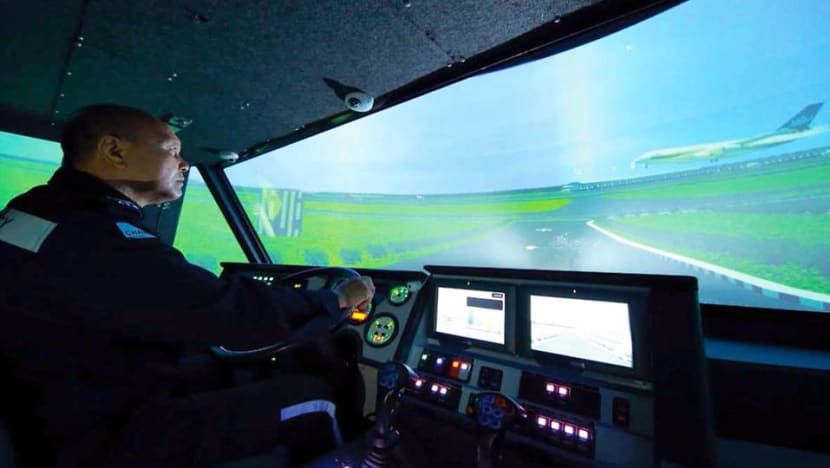
He calibrates — rain means a slippery tarmac, so continuing at such high speeds could be dangerous, especially since he has three other firefighters in his vehicle. He slows down, but only slightly. After all, he has only two minutes.
As he approaches, he sees casualties on the ground. He is careful to avoid them as he commences firefighting efforts from the vehicle. It is a virtual reality success.
A PILOT’S EYES AND EARS
The firefighters’ responses to emergencies are, in large part, determined by the information relayed from the pilot to the Air Traffic Control and then to the AES team.
What a pilot sees, however, “is just from the cockpit itself”, noted Boey. “When we respond to an incident, we’re essentially the eyes and ears on the ground for the pilot.”
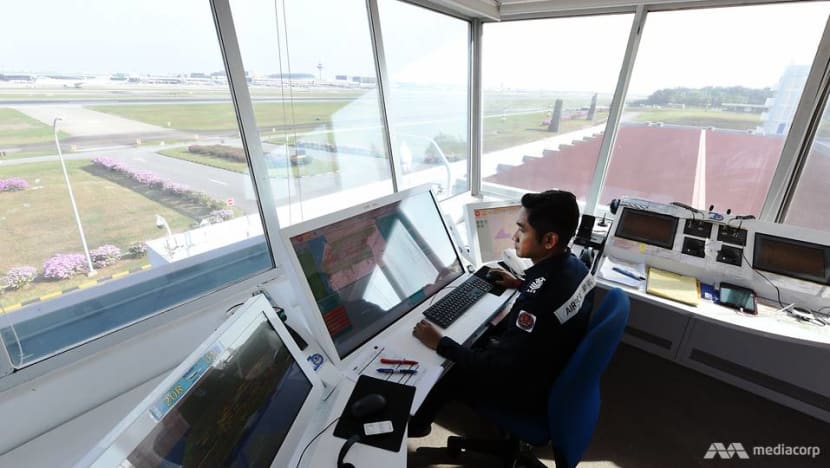
And what they see can inform their next response. For example, to an AES firefighter, smoke is not always or just an indicator of fire. White smoke could indicate overheating of equipment, burning grass or early-stage burning.
“If it’s black smoke,” said Boey, “it’s confirmed a fire.”
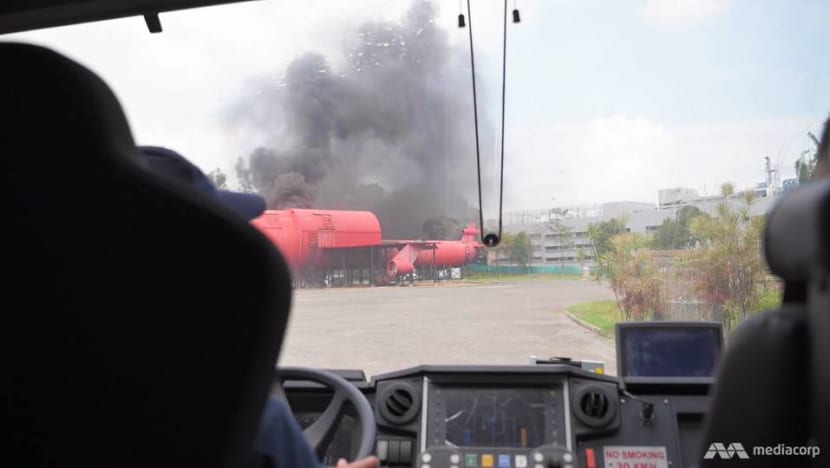
The firefighters learn to identify whether planes are carrying chemical, corrosive or explosive substances. This enables them to adhere to the regulatory safety distance.
Wind direction is another factor they must take into consideration.
Unlike the city centre, surrounded by high-rise buildings that block the wind, an airport is situated in a wide open space, so the planes are vulnerable to strong gusts as well as the wind direction.
“Wind direction can be our friend; it can also be our enemy,” said Boey.
The firefighters aim their foam solution in an upwind position, which also helps to direct the trajectory of the spray towards the fire.
“(An) aircraft firefighter needs to have the ability to think on his feet and react to situations,” said Boey. “We don’t have the luxury of time.”
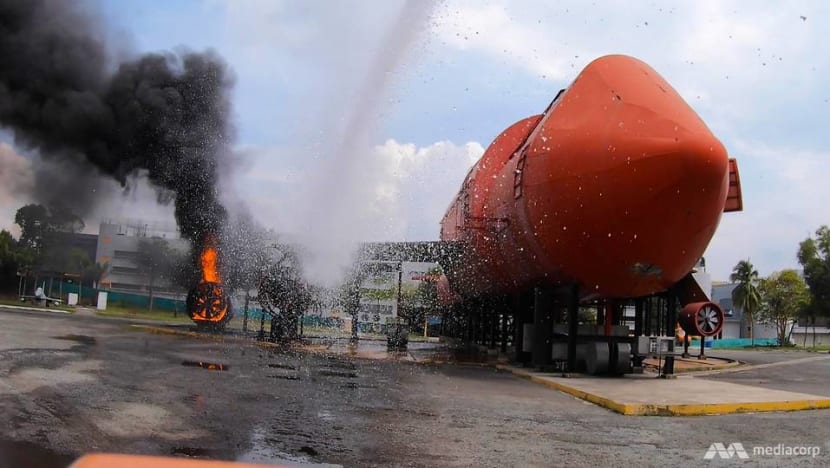
However, some people, according to Shek, are “not aware of who’s taking care of runway emergencies” and think it is part of the general firefighting service. “I have to explain to them," he said.
Despite the lack of awareness, he is proud to be part of the service, especially when he wears his uniform in public.
Ang can also relate to the lack of awareness about the team, though it is not “adulation” he wants out of the service.
Citing a “memorable” accident between a van and a lorry that occurred in the cargo complex years earlier, he described the van driver being trapped and unable to move.
The team had to extricate the man by first using a hydraulics spreader to prise the dashboard away from him.
“When the person thanks you,” said Ang, “it gives you a certain warmth — that you’ve done something right for humanity.”
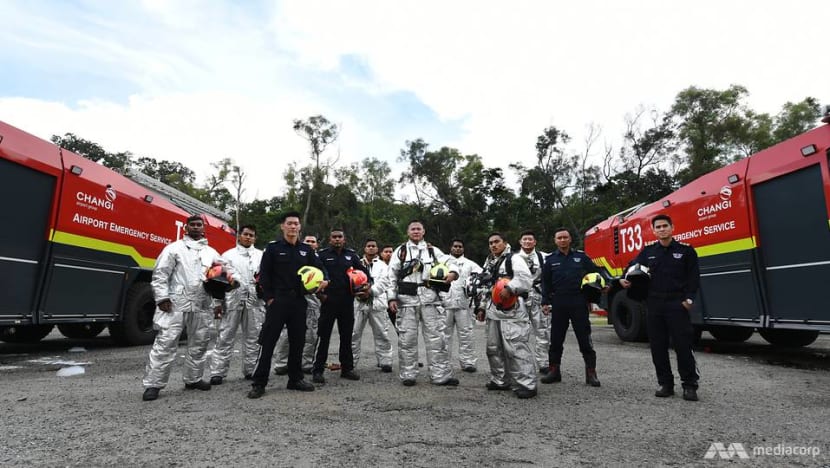
Editor's note: An earlier quote from Ang Kheng Wee in this story has been edited, following clarification from Changi Airport Group.













